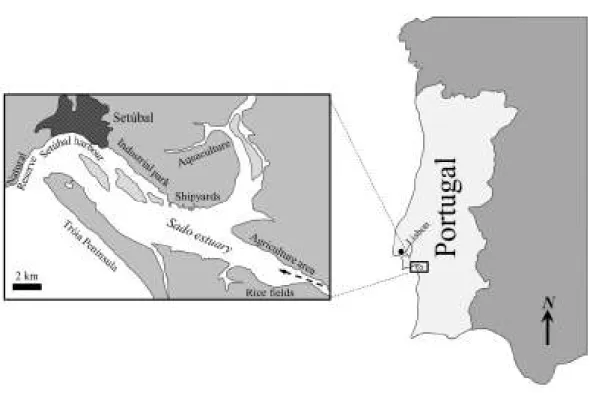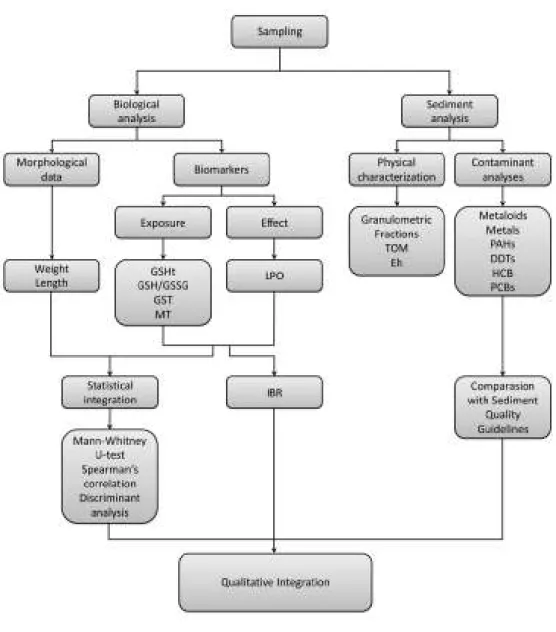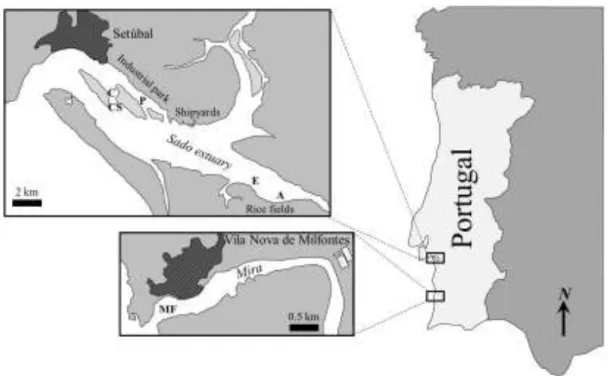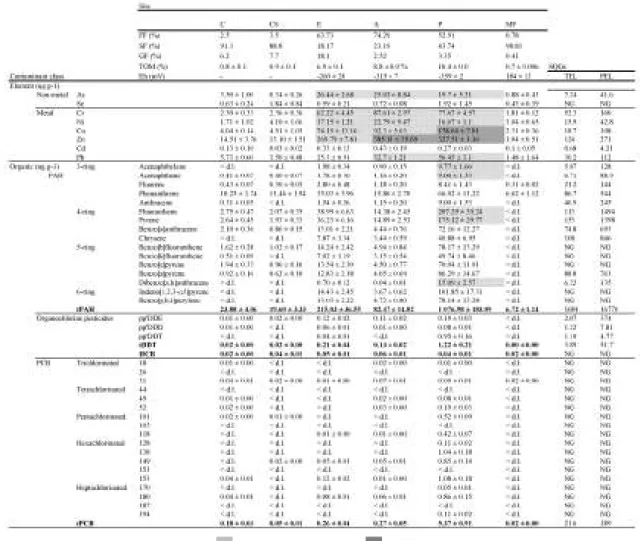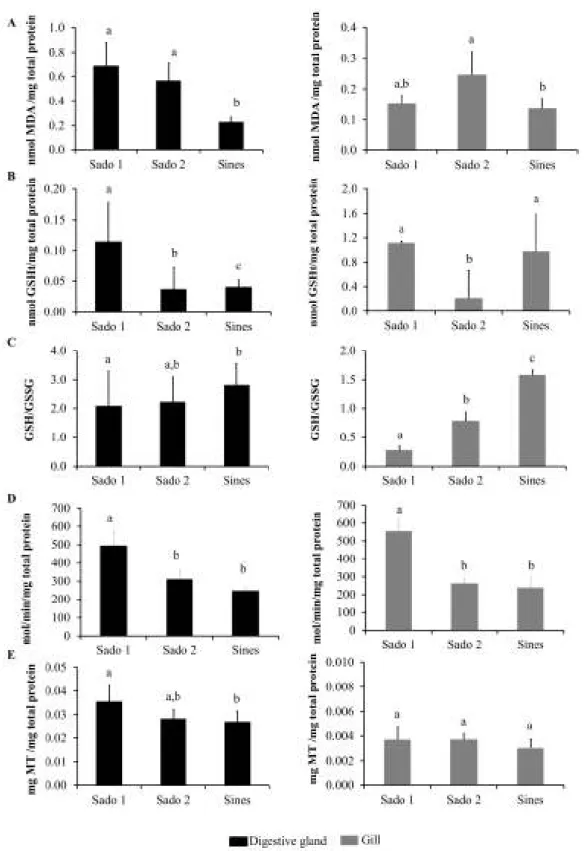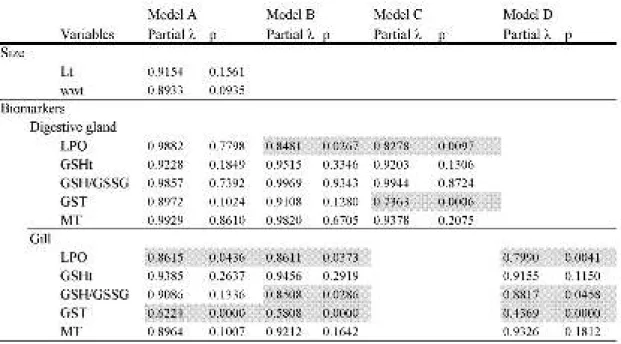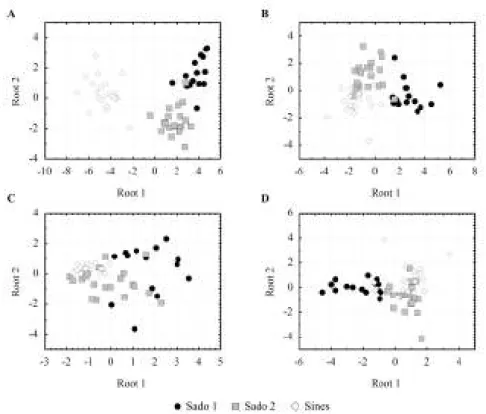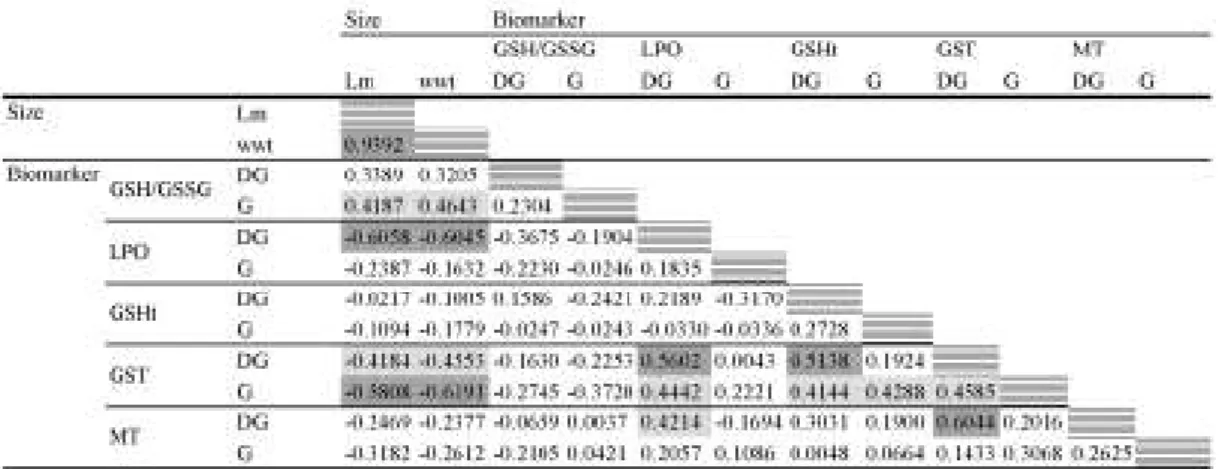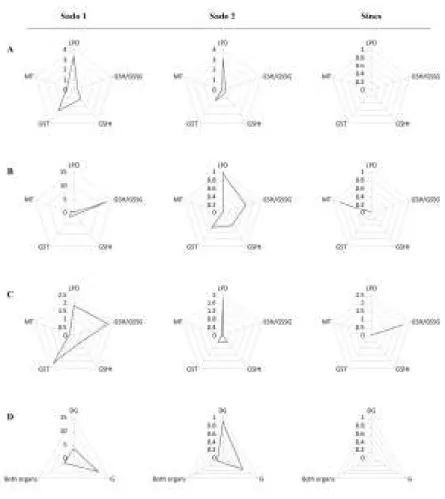i
Ana Patrícia Carreira Rodrigo
Licenciada em Ciências de Engenharia do Ambiente
Integration of sediment contamination with multi
–
biomarker responses in a novel bioindicator candidate
(Sepia officinalis) for risk assessment in impacted
estuaries
Dissertação para obtenção do Grau de Mestre em Engenharia do Ambiente
Orientador: Prof. Doutora Maria Helena Ferrão Ribeiro da
Costa, Professora Associada com Agregação, Faculdade
de Ciência e Tecnologia da Universidade Nova de Lisboa
Co
–
orientador: Doutor Pedro Manuel Broa Costa,
Investigador Sénior do IMAR
–
Instituto do Mar
Faculdade de Ciências e Tecnologia
Universidade Nova de Lisboa
iii
Integration of sediment contamination with multi–biomarker responses in a novel bioindicator candidate (Sepia officinalis) for risk assessment in impacted estuaries
Ana Patrícia Carreira Rodrigo
Statement of Copyright
v Dedicatória
À Professora Maria Helena Costa, por me ter transmitido a sua paixão, conhecimento e orientado na minha vida académica.
Ao Pedro Costa por todo o apoio dado, muito para além do esperado, pelo conhecimento transmitido, pela paciência de santo e por acreditar em mim.
À Sandra Caeiro, IR do projecto HERA (PTDC/SAU-ESA/100107/2008), no âmbito do qual se insere esta tese.
A todos os colegas de laboratório, em especial para a Marta, Jorge e a Sara, que ajudaram-me em tudo o que poderam e deram-me todo o seu apoio, tando nos momentos de maior aflição, como nos de maior descontracção.
Às minhas amigas de infânica, Andreia, Dulce, Sara e Sandra e também vizinhas Ana Margarida e Sara, que estiveram presentes em todas as brincadeiras e saídas, desde a primeira barbie até à primeira bebedeira, um especial obrigado por terem acompanhado todas as etapas da minha vida, mesmo quando seguindo caminhos e ideologias diferentes.
Aos amigos que permaneceram do secundário, especialmente, à Rita “hippie” as longas conversas e tardes partilhadas, à Tânia a bipolaridade divertida e as demonstrações de hip hop que tanta nostalgia trazem, ao Zegre pelas tardes bem passadas a fazer panquecas e batatas fritas e ao Ventorinha por todas as conversas, desde filosóficas a aparvalhadas.
Aos amigos que a faculdade trouxe e que permanecerão, por toda a ajuda dada durante o curso e por todos os jantares para desanuviar.
Ao nave, especialmente à comunidade de escalada, por me terem feito enfrentar medos e inseguranças, tornando o impensável possível e por acreditarem em mim.
Aos surfistas amigos, em especial aos antigos” maçaricos”, que cresceram e evoluiram comigo e sempre me incentivaram e ajudaram a ir além das capacidades que pensava máximas, um muito obrigado por terem tido um papel activo na surfista que sou hoje e no que isso me fez evoluir como pessoa.
Aos meus tios, primos e avós, que mesmo longe, estão sempre perto. À minha prima Mónica, por ter sido, e continuar a ser, como uma irmã.
Aos meus pais, um agradecimento para além do possível, por me terem tornado na pessoa que sou hoje, ajudando-me a alcançar e ultrapassar todas as etapas da vida, nem sempre concordando, mas sempre apoiando.
À minha irmã e melhor amiga, por toda a força dada, todas as energias revitalizadas e pelo acompanhamento no caminho percorrido até hoje, um obrigado do fundo do coração.
Ao Vitor, pelo amor dado nas situações em que mais precisei, pela paciência nos momentos mais stressantes e pela companhia em todos eles.
vi
vii Abstract
The Sado estuary (SW Portugal) is an example of the type of pressures coastal areas are subjected to, encompassing fisheries, agriculture, industries and other human activities, most of which may act as sources of aquatic pollution. In order to assess the impact of aquatic contaminants onto the biota, biomonitoring is compelling and the search for suitable bioindicator organisms is mandatory. The common cuttlefish, Sepia officinalis, is a very important species to fisheries, especially in the Sado estuary, albeit yet unsurveyed in ecotoxicological studies. For the purposes of biomonitoring, cuttlefish were collected from two different sites in the Sado estuary and from an external reference area. Additionally, environmental contamination was determined from sediment samples. Sediments were characterized for granulometric fractions, total organic matter, redox potential and for the levels of metals (Cr, Ni, Cu, Zn, Cd and Pb), metalloids (As and Se), polycyclic aromatic hydrocarbons (PAHs), polychlorinated biphenyls (PCBs) and the pesticides dichloro diphenyl trichloethane plus its main metabolites (DDTs) and hexoclorobenzene (HCB). A multi– biomarker approach was applied in two organs, digestive gland and gills, through the analysis of lipid peroxidation, total glutathione, the reduced/oxidised glutathione ratio, glutathione S– transferase activity and induction of metallothionein–like proteins. The results showed that the Sado estuary is especially contaminated by metals when compared to the reference area. In addition, even within the Sado estuary, considerable heterogeneity exists regarding sediment contamination. The biomarker responses, especially in the digestive gland, were overall consistent with sediment contamination. This relationship was less obvious in the gills, reflecting, nevertheless, high sensibility to environmental pressures. Thus, S. officinalis revealed to be a good species to address environmental contamination and likely an adequate bioindicator in environmental risk assessment programs. The integration of all biomarker responses disclosed that the levels of contamination of the Sado estuary, although considered to be moderate, cause responses and adverse effects in organisms, from which it may be inferred that current management policies have not yet been able to eradicate pollution from this ecosystem.
ix Resumo
O estuário do Sado exemplifica o tipo de pressões a que zonas costeiras estão sujeitas, como pesca, agricultura, indústria e outras actividades antropogénicas que podem ser potenciais fontes de poluição aquática. Por forma a determinar qual o impacto que contaminantes presentes no meio aquático podem exercer sobre o biota, é necessária biomonitorização, sendo por isso imprescindível a procura por um organismo bioindicador adequado. O choco, Sepia officinalis, é uma espécie com grande relevância para a pesca, especialmente no estuário do Sado. No entanto, a espécie não foi ainda aplicada em estudos ecotoxicológicos. Como parte de um programa de biomonitorização, foram recolhidos espécimes em dois pontos de amostragem diferentes no estuário do Sado e num outro local externo, definido como área de referência. Foi também determinada a contaminação ambiental através de análises aos sedimentos. Os sedimentos foram caracterizados fisicamente (fracções granulométricas, matéria orgânica total e potencial redox) e foram determinados os níveis de contaminação de metais (Cr, Ni, Cu, Zn, Cd e Pb), metalóides (As e Se), hidrocarbonetos aromáticos policíclicos (PAHs), bifenis policlorados (PCBs) e os pesticidas dicloro–difenil–tricloroetano e principais metabolitos (DDTs) e hexaclorobenzeno (HCB). Uma abordagem de múltiplos biomarcadores foi aplicada a dois orgãos, glândula digestiva e brânquias, através da análise da peroxidação lipídica, glutationa total, do rácio glutationa reduzida/oxidada, actividade da glutationa S–Transferase e indução de proteínas semelhantes a metalotioninas. Os resultados obtidos demonstraram que o estuário do Sado está contaminado, principalmente por metais, comparativamente à zona de referência. Mesmo dentro do estuário do Sado, é evidenciada uma grande heterogeinidade de contaminação sedimentar. As respostas dos biomarcadores, principalmente na glândula digestiva, foram consistentes com a contaminação sedimentar. Esta relação foi menos evidente nas brânquias, apresentando, no entanto, uma grande sensibilidade para pressões ambientais. Deste modo, S. officinalis demonstrou ser uma espécie adequada para reflectir contaminação ambiental, podendo ser um bioindicador apropriado para programas de determinação de risco ambiental. A integração das respostas de todos os biomarcadores revelou que os níveis de contaminação do estuário do Sado, apesar de considerados moderados, dão origem a respostas e efeitos adversos nos organismos, podendo assim ser evidenciado o facto de que as actuais medidas de gestão aplicadas, ainda não terem sido capazes de erradicar a poluição do ecossistema em questão.
xi Index
Figure Index ... xiii
Table Index ... xv
Abbreviation list ... xvii
1. Introduction ... 1
2. Material and Methods ... 7
2.1. Sediment sampling and characterization ... 7
2.2. Animal collection ... 9
2.3. Biomarker analysis ... 9
2.4. Statistical analysis ... 11
2.5. Integrated Biomarker Response (IBR) ... 11
3. Results ... 13
3.1. Sediment characterization ... 13
3.2. Biological responses ... 15
3.3. Statistical integration of data ... 17
3.4. Integrated Biomarker Response (IBR) ... 20
4. Discussion ... 21
4.1. Contamination profiles ... 21
4.2. Biomarker approach ... 23
5. Conclusions ... 29
xiii Figure Index
Fig. 1.1. Map of the Sado estuary ... 4
Fig. 1.2. Research layout ... 5
Fig. 2.1. Sediment collection sites of the Sado and Mira estuaries ... 7
Fig. 2.2. Organism collection sites... 9
Fig 3.1. Mean results of biomarker responses per site in digestive gland and gills ... 16
Fig 3.2. Results from discriminant analysis ... 18
xv Table Index
xvii Abbreviation list
As – Arsenic Cd – Cadmium Cr – Chromium Cu – Copper
DDT – Dichloro Diphenyl Trichloethane DG – Digestive Gland
DW – Dry Weight
EC – European Community Eh – Redox Potential
ERA – Environmental Risk Assessment
FF – Sediment fine particle fraction (< 0.063 mm) GF – Sediment gravel particle fraction (0.063 – 2 mm)
GC–ECD – Gas Chromatography with an Electron Capture Detector GC–MS – Gas Chromatography–Mass Spectrometry
GSH – Reduced glutathione GSHt – Total glutathione GSSG – Oxidised glutathione GST – Glutathione S–Transferase HCB – Hexaclorobenzene
IBR – Integrated Biomarker Response LPO – Lipid Peroxidation
Lt – Mantle length MDA – Malondialdehyde
MSFD – Marine Strategy Framework Directive MT – Metallothionein–like protein
Ni – Nickel
PAH – Polycyclic Aromatic Hydrocarbon PCB – Polychlorinated Biphenyl
PEL – Probable Effects Level Pb – Lead
ROS – Reactive Oxygen Species
SF – Sediment sand particle fraction (> 2 mm) Se – Selenium
SQG – Sediment Quality Guideline
xviii TEL – Threshold Effects Level
TOM – Total Organic Matter WFD – Water Framework Directive wwt – Total wet weight
1 1. Introduction
Coastal environments, especially confined waterbodies such as estuaries, are impacted by various anthropogenic pressures, being the release of xenobiotics, inherent to many human activities, one of the greatest concerns. Ecological Risk Assessment (ERA) is one of the most acknowledged approaches to assess the problem of coastal pollution. This procedure can be divided, according to the type of process, in risk analysis which in essence aims at determining the potential hazard from a certain situation (a more scientific process) and risk management which provides solutions to a certain problem (a more political procedure). The process of ERA may comprise several steps (often consisting of a tiered approach, e.g., from environmental contaminant analyses to the determination of its potential effects to organisms), being biomonitoring one of the most important stages (see Chapman, 2007, for a review).
2
MEDPOL (for the Mediterranean), HELCOM (Baltic) or OSPAR, the latter of pertinence for Portugal.
In order to meet a favourable Descriptor 8, not only chemical analyses should be performed but also biological determinations in order to have an integrated knowledge of the ecosystem and to demonstrate the real impact contaminants have on the organisms (Chapman, 2007). In order to address the biological impacts of contamination, the biomarker approach has come to age and proven its value in both field and laboratory situations (including bioassays). In fact, biomarkers have been widely employed in wild organisms and those subjected to bioassays, defined as laboratory ecotoxicity tests where organisms’ life patterns are chosen as endpoints, in order to clarify the relationship, if any, between exposure to a xenobiotic compound and the organisms’ health status (reviewed by van der Oost et al., 2003). Biomarkers can be defined as quantitative measures of changes in the biological system, viewed as short–term indicators of long–term biological effects (van der Oost et al., 2003). However, they can also act as early warning signals of the presence of potentially toxic compounds, that way being useful to assess either exposure to or effects of these substances, providing information about the toxicants’ bioavailability (Picado et al., 2007).
3
evaluate the effects of pollutants on individuals and enable an assessment of the effects of different contaminants present in the aquatic environment (see, for instance, Picado et al., 2007).
To address the contamination of a certain aquatic ecosystem with the assistance of biomarkers, the surveyed species should be in accordance with their relevance to the ecosystem (Martín– Díaz et al., 2008). Benthic organisms are of great importance mainly due to their interaction with the most important reservoir of xenobiotics, sediments, with especial respect to estuaries and other confined waterbodies. For the purpose, molluscs have been widely surveyed in biomonitoring programs, owing to their ecological and economical importance, albeit the vast majority of the studies are focused on clams, cockles and mussels, i. e., sessile organisms, thus potentially reflecting the conditions of narrower areas, comparatively to foraging animals. Among the latter, benthic fish are often considered prime targets for ecotoxicological surveys, whereas cephalopod molluscs (octopuses and cuttlefish) remain little studied, even though they combine perfectly foraging ability with the molluscan basic body plan and physiology, which have been rendering acknowledged results within the scope of ecotoxicology. In addition, cephalopods possess high commercial value, continuously rising in the last years, at the same time fish stocks decrease (reviewed by Guerra et al., 2010). A possible explanation for this fact is the great resilience to environmental changes seen in species of this class, such as the common cuttlefish, Sepia officinalis (Linnaeus, 1758) (Guerra, 2006). Still, no ecotoxicological research has been found to date focusing on S. officinalis as sentinel/biomonitoring organism, although Bustamante et al. (2006), in an entirely laboratorial study (with hatchery–brooded animals) surveyed metal accumulation in these animals. Sepia officinalis is found throughout the Mediterranean basin and the eastern Atlantic Ocean, from Southern Norway and Northern England to the northwestern coast of Africa (Guerra, 2006). In Portugal, cuttlefish can be found throughout the coast, which contributes to its high importance for traditional fisheries (Guerra, 2006; Neves et al., 2009).
4
(Costa et al., 2008a, 2008b; Caeiro et al., 2009). Closer to the river mouth, in the southern region of the estuary, the fishing pressure is felt mostly during summer and extensive agriculture grounds, mostly rice fields, likely bring to the basin pesticides and fertilizers (Costa et al., 2009, 2011). With all the pressures and conflicts existing in the estuary, the necessity to implement ERA strategies has risen, involving contaminant analyses in most of the estuary (Caeiro et al., 2005, 2009; Costa et al., 2012a) and biomarker analyses in some of the most relevant commercial species to estuary’s fisheries: flatfish (Costa et al., 2008a, 2009, 2011) and clams (Carreira et al., 2012; Costa et al., 2012b).
Fig. 1.1. Map of the Sado estuary.The arrow indicates the river flow
The layout of the research is present at Fig. 1.2. The main objectives of this thesis are summarised as follows:
To integrate sediment contamination with organisms’ responses in order to unveil if environmental toxicants elicit adverse effects to the target species;
To provide an accountable measure of contamination in the Sado estuary through a biomarker approach;
5
7 2. Material and Methods
2.1. Sediment sampling and characterization
Sediment samples were collected from different sites in the north and south areas of the Sado estuary and from the reference site – the Mira estuary (Fig. 2.1), an area considered devoid of direct inputs of hazardous substances and the least impacted estuary in Portugal (Vasconcelos et al., 2007). From the samples collected in the north Sado, C and CS consist of sandy shellfish beds with strong oceanic influence and P is adjacent to the heavily industrial area located nearby the city of Setúbal. In the south Sado, A and E are muddy shellfish beds adjacent to agricultural areas at the mouth of the river Sado. These sites were chosen due to the heterogeneous nature of Sado sediments, in order to have an overview of the commercial fishing areas. Mira sediments were sampled just off the estuary (MF) due to logistical constraints of sampling sediments in the open sea, the area where organisms from the site termed Sines were collected (see below). All sediments were collected using a grab and during the same seasons in which organisms were captured, i. e., E and A in Spring–Summer and MF and P during Fall–Winter.
Fig. 2.1. Sediment collection sites of the Sado and Mira (reference) estuaries, termed C, CS and P (Sado
north); E and A (Sado south) and MF (Mira).
8
disaggregation with pyrophosphate and washing. Total organic matter (TOM) was determined by carbon loss–at ignition at 500 ± 25⁰ C during 4 h. Both results are expressed as percentage per total sediment dry weight (DW). Sediment redox potential (Eh) was measured immediately after collection, using an Orion model 20A meter with a H3131 Ag/AgCl reference electrode.
Sediment metalloids (arsenic – As and selenium – Se) and metals (chromium – Cr, nickel – Ni, copper – Cu, zinc – Zn, cadmium – Cd and lead – Pb) were determined according to Caetano et al. (2007). In brief: dry sediment samples were mineralized with a mixture of acids (6 mL HF 40% v/v and 1 mL of the mixture 36% HCl plus 60% HNO3 3:1 v/v) in closed Teflon vessels heated during 1 h at 100 ⁰C, followed by heating for further 20 min at 75 ⁰C after the addition of HNO3 to the evaporated contents of the Teflon vials. Samples were afterwards eluted with MilliQ–grade water (18.2 mΩ.cm) to 50 mL. Elements were quantified by inductively coupled plasma mass spectrometry (ICP–MS) using a Thermo Elemental X–Series equipment. Reference sediments, MESS–2 and PACS–2 (National Research Council, Canada) and MAG–1 (US Geological Survey, USA) were used to validate the methods and the results were found within the certified range.
Polycyclic aromatic hydrocarbons (PAHs) concentrations were determined by a Finnigan GCQ gas chromatography–mass spectrometry (GC–MS) system, after accelerated solvent extraction of dry sediment samples spiked with 1 mL of surrogate standards (Supelco), with 250 mL of an acetone+hexane (1:1 v/v) mixture, using a Dionex ASE 200 apparatus, as described by Martins et al. (2012). Concentrations were measured by the internal standard peaks’ area method and with a calibration curve for each compound. A total of sixteen, three– to six–ring, PAHs were quantified. Organochlorines, namely polychlorinated biphenyls (PCBs), dichloro–diphenyl–
trichloroethane (pp’DDT) and metabolites (pp’DDD and pp’DDE) and hexoclorobenzene
(HCB) were determined by Soxhlet–extraction of dried sediments with n–hexane and quantified by GC–ECD (gas chromatography with a electron capture detector), according to Ferreira et al. (2003). The quality of determinations was validated by analysis of the reference sediment SRM 1941b (National Institute of Standards and Technology, USA), being the obtained values within the certified range.
9 2.2. Animal collection
Approximately twenty S. officinalis per site were obtained from commercial sources from the three sampling sites: Sines (of the Mira estuary) and north and south areas of the Sado estuary (Fig. 2.2). After collection, the animals were immediately transported to the laboratory, in cold containers, processed for standard measurements (total wet weight and mantle length) and dissected for collection of gill and digestive gland samples, which were frozen at –80° C for subsequent analyses.
Fig. 2.2. Organism collection sites, from commercial fishing grounds of the Sado estuary and off the city
of Sines near the Mira estuary (Portuguese SW coast, surveyed as reference location).
2.3. Biomarker analysis
Lipid peroxides were determined in the digestive gland and gills, following the thiobarbituric acid reactive substances (TBARS) protocol first developed by Uchiyama and Mihara (1978), adapted by Costa et al. (2011). In brief: approximately 100 mg of each organ samples were
homogenized in 250 μL of phosphate–buffered saline [PBS (pH 7.4, with 0.7% NaCl)],
10
precipitate protein. After a 2 200 g, 15 min centrifuging, 100 μL of 0.1% m/v thiobarbituric acid (TBA) was added to 100 μL of the clear supernatant and heat–treated (at 100⁰ C) for 15 min. The resulting red pigment was extracted with a mixture of pyridine:butanol (1:15) and the absorbance measured at 530 nm. To each well of the 96–well plates used were added 150 μL of the reaction, samples, blanks and standards. Determination was done through an eight–point calibration curve using malondialdehyde bis(dimethylacetal), from Merck, as standard.
Total glutathione (GSHt) was determined from approximately 100 mg of digestive gland and gill tissue through the enzymatic recycling method, using a commercial kit (Sigma–Aldrich), following manufacturer instructions, by measuring the increase in the absorbance of the reactions at 412 nm during 5 min at 1 min intervals. The GSH/GSSG (reduced/oxidised glutathione) ratio was estimated following derivatization of GSHt subsamples with 2– vinilpyridine (Sigma–Aldrich), in order to obtain the GSSG concentration alone. The ratio was determined as GSH/(GSSG/2).
To estimate Glutathione S–Transferase (GST) activity a homogenate was made from approximately 100 mg of digestive gland and gill tissue with 300 μL of PBS, followed by centrifugation (5 min, 7 000 g). Activity was determined in supernatant dilution (1:10), by measuring the increase in absorbance at 340 nm during 5 min, using chloro–2,4–dinitrobenzene (CDNB) as substrate. The procedure was performed using a commercial kit (Sigma–Aldrich), according to manufacturer instructions. An aliquot of the same homogenate was used to quantify metallothionein–like protein (MT) using the protocol described by Costa et al. (2008b), following from Palecek and Pechan (1971), with modifications. In brief: after centrifuging the homogenate for 10 min at 12 000 g, the diluted (1:10) supernatant (extracted cytosol) was heated ( 80 ⁰C, 10 min) and centrifuged (10 min, 12 000 g), to precipitate non heat–stable protein. In absence of an available commercial cuttlefish MT, MT–1 from rabbit liver (Alexis Biochemicals) was used to obtain a five–point calibration curve. Metallothionein–equivalents were measured by differential pulse polarography (DPP) with a static mercury drop electrode (SMDE) using a Metrohm 694 stand and a 693 processor. The electrode system consisted of a mercury capillary working electrode, an Ag/AgCl reference electrode and a platinum auxiliary electrode. The supporting electrolyte contained 1 M NH4Cl, 1 M NH4OH and 2 mM [Co(NH3)6]Cl3.
11 2.4. Statistical analysis
After the violation of at least one of the assumptions for parametric analysis, namely homogeneity of variances (through the Levene’s test), non–parametric analyses were employed; specifically, the Mann–Whitney U test to search for inter–site differentiation, and the non–
parametric Spearman’s Rank–order correlation R statistic. All variables (biomarker responses
and morphometrics) were modelled trough multivariate statistics, namely discriminant analysis, to determine the significance of each variable in site differentiation. A significance level α = 0.05 was set for all analyses. All statistics were performed using Statistica (StatSoft).
2.5. Integrated Biomarker Response (IBR)
The IBR index was computed to integrate all biomarker responses previously illustrated, according to the method described by Beliaeff and Burgeot (2002). In brief: the score (S) for each biomarker in each site and for each organ and for both was calculated trough the formula:
Min
Z
S
[1]Where S ≥ 0, |Min| is the absolute value and
s m X
Z [2]
With Z being positive or negative depending on the activation or inhibition, respectively, of the biological effect. The standardized values Z were estimated through the mean value for each biomarker in each site (X), the mean value for each biomarker (m) and the standard deviation of X (s). The area (A) connecting two consecutive coordinates was calculated for each biomarker result in star plots, being Si and Si+1 two consecutive scores and n the number of biomarkers considered:
cos
sin
sin
2
1
i i ii
S
S
S
A
12 Where:
cos
sin
arctan
1 1 i i iS
S
S
and n
2[4]
13 3. Results
3.1. Sediment characterization
14
Table 3.1. Sediment characterization of the samples collected from Sado (C, CS, P, E and A) and Mira
(MF). The PEL and TEL sediment quality guidelines were obtained from MacDonald et al. (1996).
15 3.2. Biological responses
There were differences between all sites for all studied biomarkers and different response patterns between digestive gland and gills, except for GST and LPO (Fig. 3.1). All biomarker results in the digestive glands revealed a clear differentiation between Sado 1 and Sines, whereas in gills segregation was obtained only for GSH/GSSG ratio and GST. Sites Sado 2 and Sines were differentiated by LPO and GSHt in both organs and by GSH/GSSG ratio in gills. GSHt and GST in both organs plus GSH/GSSG ratio in gills significantly segregated Sado 1 from Sado 2. The biomarker yielding higher inter–site differentiation in gills was the GSH/GSSG ratio while for the digestive gland was GSHt. The biomarkers showing the highest differences towards Sines (reference site) were LPO and GSHt in digestive gland, reaching values three times lower than in Sado 1.
16
Fig 3.1. Mean results of biomarker responses per site (Sado 1, Sado 2 and Sines) in digestive gland and
17 3.3. Statistical integration of data
Discriminant analysis was performed by deriving four models (A–D) with different variables in each (Table 3.2). In model A (all variables included), no relevant variables were found (p > 0.05) concerning size and digestive gland biomarkers, being gill LPO and GST the best variables to distinguish sites. In model B the three gill variables (LPO, GST and GSH/GSSG) were still significant, together with LPO in digestive gland. When taking into account only digestive gland biomarkers (C), LPO and GST became significant. In the model with only gill biomarkers (D), besides LPO and GST, GSH/GSSG ratio also became significant. There was a general tendency for LPO and GST biomarkers, especially in gills, to consistently be the most significant biomarkers for site differentiation.
Table 3.2. Results from discriminant analyses. Model A) length, weight and all biomarkers studied for
both organs (LPO, GSHt, GSH/GSSG, GST and MT) (total λ = 0.02548, p<0.00); model B) all biomarkers studied, for both organs (total λ = 0.14004, p<0.00); model C) digestive gland biomarkers alone (total λ = 0.40955, p<0.00); model D) gill biomarkers only (total λ = 0.23253, p<0.00).
18
All models rendered inter–site differentiation (Fig. 3.2). In the model including all biomarker responses in digestive gland and gills plus length and weight, a clear differentiation of Sines was obtained, together with a good separation of both sites from Sado (Fig. 3.2A). In the model without length and weight (Fig. 3.2B), the site segregation is reduced but still achieved, and in models C and D (Figs. 3.2C and 3.2D, respectively) a less conspicuous site separation was observed, when comparing with models A and B. Gill biomarkers (Fig. 3.2D) could better differentiate sites than digestive gland responses, especially regarding site Sado 1.
Fig 3.2. Results from discriminant analysis. Scatterplot of canonical scores for site differentiation (Sado
1, Sado2 and Sines) considering different variables in each case; A) length, weight plus all biomarkers studied in both organs (LPO, GSHt, GSH/GSSG, GST and MT); B) biomarkers only (both organs); C) digestive gland biomarkers only; D) gill biomarkers alone.
19
digestive gland and LPO, GSHt and MT in digestive gland. Lower, but still significant, correlations (R > 0.4) occurred between MT and LPO in digestive gland and between GST in gills and also between GST, LPO and GSHt in the digestive gland and GSHt in gills. All the within–biomarker correlations statistically significant (R > 0.4 and p < 0.05) were positive.
Table 3.3. Spearman’s correlation R statistics (all variables, all sites pooled). Highlighted statistics are
significant at p < 0.05.
20 3.4. Integrated Biomarker Response (IBR)
As can be observed from Fig. 3.3, Sado 1 was the site with higher IBR scores, followed by Sado 2, whereas for Sines these were almost null, existing only one discriminant factor when considering gills MT or the GSH/GSSG ratio for both organs. In general, LPO was one of the most significant biomarkers, especially in digestive gland and in Sado 2. IBR values were calculated based on the following biomarker order, according to the order of responses by the organism: LPO > GSHt > GSH/GSSG > GST > MT. Overall, the integrated responses obtained for site Sado 1 were higher in gills, while in digestive gland they were higher for Sado 2.
Fig 3.3. Integrated biomarker response (IBR) star plots for each site, considering all biomarkers and both
21 4. Discussion
The present study revealed different biomarker patterns between S. officinalis collected from the three sites. In addition, there were differences in biomarker responses between digestive glands and gills. The differences between biomarker responses, with especial respect to the digestive gland, is in good agreement with environmental contamination of the Sado estuary, since the Sado sites, when compared to the reference locations, yielded higher contamination levels and animals exhibiting higher biomarkers responses. The findings are sustained by the results obtained from IBR, a complementary leverage to the results obtained by the statistical analyses, which examines differences in response between populations and test groups combining various biomarker responses into a single index (Broeg and Lehtonen, 2006). The IBR evidenced Sado 1 as the most contaminated site, confirming the advantage of measuring biomarkers in different organs, since the gills responded better in site Sado 1, while the digestive glands in site Sado 2, and enhance the notion of which are the best biomarkers to reflect site contamination (LPO, GST and GSH/GSSG). However, some considerations should be taken into account when considering IBR, such as the hierarchy considered, the number of biomarkers and their relative weight, to which is added the fact that it is a dynamic index, thus cannot be used in direct comparison (Damiens et al., 2007; Tsangaris et al., 2011; Serafim et al., 2012).
4.1. Contamination profiles
The contrast between sediment contamination profiles and the available SGQ’s allowed the detection of the compounds potentially representing a higher risk. The results are consistent with previous sediment analyses performed in the Sado estuary and compiled by Costa et al. (2012a), that revealed metals, especially Zn and Cu, as the contaminants posing a higher risk, due to their levels surpassing the PEL. Regarding PAHs, variations in concentrations exceeding TEL values were seen, with differences from previous studies, having, nevertheless, concentrations close to TEL values, like for benzo[a]anthracene and benzo[a]pyrene. Organochlorines and PCBs showed low values, well below TEL, consistent with former analyses (Costa et al., 2011, 2012a), thus representing low risk.
22
Costa et al. (2008a). The basic physic–chemical characteristics of the sediments are likely to play a major role in contaminant bioavailability, since the most contaminated sites had also higher FF and TOM and lower Eh, which is also consistent with the findings of the aforementioned studies. High proportions of FF and TOM may act as a trap for contaminants, possibly reducing the potential negative impact expected from analysing contaminants concentration, especially for metals, due to their high affinity by sediments with these characteristics (Caccia et al., 2003; Neuparth et al., 2005; Costa et al., 2008a). On the other hand, low Eh, as found in the most contaminated sites in the Sado estuary and in line with previous analyses described by Costa et al. (2012a), likely increase bioavailability upon resuspension of sediments (Caccia et al., 2003; Eggleton and Thomas, 2004). Overall, it may be inferred that the sites subjected to higher anthropogenic pressures, not only industrial (site P) but also agricultural (sites A and E), are the ones with higher contamination.
23
mouth, close to these sites, yielded the highest values for Zn and Cd in the estuary, which is consistent with the present results (Cortesão and Vale, 1995). In fact, some of the analysed metals attained higher concentrations in sites A and E (especially A), than in site P. Possible explanations can be the mining activities in the river drainage basin (Vale and Cortesão, 1989), the fertilizers applied in agriculture, some of which may have metals (Cr, Cu, Cd, Zn and Ni) as constituents (Nziguheba and Smolders, 2008), and the pesticide use (see, e.g., Cerejeira et al., 2003 and Villaverde et al., 2008).
Site MF was considered as reference for sediment contamination, since it can be regarded as representative of the area of SW Portuguese coast, where cuttlefish were captured (indicated as site Sines). This area has high hydrodynamics and the bottoms are constituted mostly by a medium to coarse sand. Still, few data exist regarding sediment contamination of the SW Portuguese coastline, however, some past work reported low or null contamination profiles by metals (Cr, Cu, Ni, Pb and Zn) and a metalloid (As) in this area, consistent with the levels hereby described (Anonymous, 2004).
4.2. Biomarker approach
The biomarker responses were overall consistent with sediment contamination, with higher levels of response and damage (the latter given by LPO) being seen in cuttlefish from site Sado 1 (northern fishing grounds), however with differences between sites more pronounced in gills than in digestive glands. Since digestive glands may tend to reflect a more chronic exposure than gills, several explanations can be formulated: the contamination levels were not high enough to inflict considerable cumulative damage in the sampled cuttlefish; cuttlefish has high mobility and thus not reflecting the directly environmental contamination; cuttlefish may have a high autoregulation capacity for moderate levels of contamination. However, not all biomarkers are best expressed in gills, as the example of MT, which has a better expression in inter–site differentiation in the digestive glands, probably due to the organ’s ability to store high metal levels, whereas gills reflect the pathway for metal uptake and short–time storage, as previously observed in the octopus Octopus vulgaris and in different fish species (Hamza–Chaffai et al., 1995; Raimundo et al., 2010).
24
from the digestive glands, regardless of their significance for site differentiation (such as MT and GSHt), were strongly correlated with the remaining digestive gland biomarkers, probably due to the fact that this is a highly active organ where contaminants tend to accumulate, since is the seat of most regulatory processes, namely the excretion pathway (see van der Oost et al., 2003 for specifics). For instance, a strong positive correlation was observed between MT and LPO, probably meaning that the protective antioxidant role of MT was not sufficient to prevent oxidative stress, contrary to what Correia et al. (2002) found in amphipod Gammarus locusta exposed to Cu to sediments from the Sado estuary for a short period of time (28 days).
25
explanation for the higher LPO. Still, caution has to be taken when interpreting these results, since in fish it has been registered higher lipid peroxidation in winter and autumn (Serafim et al., 2012). A negative correlation was observed between cuttlefish size and lipid peroxidation in the present study. Besides environmental contamination and naturally–occurring individual size differences between the surveyed biogeographical areas, unsurveyed biological factors, such as feeding, may also be involved in lipid peroxidation, since cuttlefish feeds on a wide variety of preys (Guerra, 2006).
It has been shown, in mussels, the link between LPO and exposure to metals (Pytharopoulou et al., 2008), as also supported in the present study, however, the inverse has already been reported by Viarengo et al. (1990). Links between LPO and exposure to metals have only been found when contamination levels are high (Pedrajas et al., 1995; Martín–Díaz et al., 2009). However, when amphipods, a more sensitive organism, were subject to a short time exposure, even at low levels of contaminants, lipid peroxidation occurred (Correia et al., 2002). In general, regardless of the contaminant and concentration, long–term exposures are thought to be necessary to induce lipid peroxidation (Gravato et al., 2010).
To deal with exposure to xenobiotics, the organisms may drive into motion defences to prevent oxidative damage from occurring. After phase I enzymes having biotransformed the compounds, phase II enzymes, like GST, enter into action by adding polar groups, such as GSH, to hydrophobic xenobiotics, to facilitate excretion. On the other hand, GSH itself acts as a direct antioxidant by supplying electrons to ROS, then becoming oxidised itself (GSSG), hence the importance of measuring, besides the activity of GST, also the GSH/GSSG ratio and the induction of GSHt (see van der Oost et al., 2003; Martín–Díaz et al., 2008 and Oliveira et al., 2009, for reviews). A reduction in the GSH/GSSG ratio occurred in cuttlefish according to site contamination (much more pronounced in the gills), consistent with the findings of Moreira et al. (2006) in polychaetes from the Sado estuary, that reflected the contamination sites by metals. This was also verified in cockles exposed to Cd (Taylor and Maher, 2012) and in eels exposed to organic pollutants (van der Oost et al., 1996). The higher significance of GSH in gills is probably due to their higher sensitivity and the fact that GSH is a first line of defence against ROS. Even though GSHt was not very significant for site differentiation, it was strongly correlated with the GST activity levels in both organs, as expected, since this enzyme takes part in GSH recycling.
26
contamination differences found between Sado 1 and the remaining sites. This is further evidenced by the high specificity between GST and exposure to chemicals found in fish and polychaetes (Moreira et al., 2006; Fonseca et al., 2011b). Its modulation by other environmental factors besides pollution, has been dismissed by some authors in experiments performed in fish (Kopecka and Pempkowiak, 2008;Fonseca et al., 2011b), although acknowledged by Serafim et al. (2012), regarding seasonal variation. It is known that induction of GST activity may counteract oxidative stress triggered by exposure to metals such as Cd, Cu, As, Pb and Zn (Damiens et al., 2007; Martín–Díaz et al., 2009; García–Alonso et al., 2011; Ramos–Gómez et al., 2011), and organochlorine compounds like PCBs and DDTs in clams (Hoarau et al., 2001, 2004). However, PAHs have been reported to cause either GST inhibition (Fonseca et al., 2011a) or induction (Hoarau et al., 2001; Damiens et al., 2007; Gravato et al., 2010). In the present study, PAH–triggered increase of GST activity is suggested, since the higher sediment PAH levels, the higher GST activity in both organs. However, as Fonseca et al. (2011a) suggested, factors such as species–specific responses can occur. Nevertheless, GST activity seems to reflect overall site contamination, even though no major differences were found between Sado 2 and Sines.
27
regarding MT response as a potential biomarker of exposure to metals (Mouneyrac et al., 2002; Pytharopoulou et al., 2008; Serafim et al., 2012). In addition, MT induction, in the present study, should not be explained by metals in the sediment alone, since it is known to be influenced by many biological variables, such as animal size (Hamza–Chaffai et al., 1995) and may even be triggered by organic contaminants (Costa et al., 2009). However, the interaction between metal and organic contaminants in MT biosynthesis remains unclear, since it has been seen in fish (Roméo et al., 1997), that exposure to Cu and benzo[a]pyrene increases MT induction, while Risso–de Faverney et al. (2000) reported suppression of MT induction, also in fish, in this case exposed to a PAH and a mixture of metals (Cd, Cu, Pb and Zn). There are also other possible interactions, such as the one reported by Sampaio et al. (2008), who found MT induction in fish to be modulated by both Cu and hypoxia. These facts, accompanied with the negative correlation described between free oxidative radicals and the availability of MT thiols to bind to ROS (Buico et al., 2008), reveal the possibility of MT induction to be a result of oxidative stress, an hypothesis already sustained by other authors (e.g. Costa et al., 2009). Regardless of all these contradictions and confounding factors, it is important to emphasize that most of the studies were performed with fish and not cephalopods. Nevertheless, the results obtained by the present study reveal a higher contamination pattern in Sado 1 sediments, the same site where MT expression was higher in the digestive gland which, in any instance, is in general accordance with the results from other biomarkers.
29 5. Conclusions
Although strong interaction effects between contaminants exist and are important to fully understand biomarker responses, it is also important to keep in mind that the mechanisms of toxicity are very complex and dependent of this and many other factors. This further highlights the need to integrate biomarkers and other biological and environmental parameters when applying a practical biomonitoring procedure.
The sediments from the Sado estuary revealed to be contaminated by several classes of toxicants, especially (but not exclusively) metals, when compared to the reference site. Even moderate, these levels of contamination may be regarded as pollution, since the sampled organisms showed adverse effects (as increased lipid peroxidation) and elevated responses to stress. Sediments, due to their ability to work as a reservoir, most likely contribute to the overall ecological risk of the area. Moreover, within the Sado estuary, considerable inter–site variation was found, regarding both sediment contamination and organism health status, thus evidencing the ecotoxicological heterogeneity of the Sado estuary.
The digestive glands yielded better results. i. e., more relatable to the environmental characterization and, overall, appears to be a better organ to reveal the effects of contamination in cuttlefish. Nevertheless, the gills were a better organ for inter–site differentiation, revealing higher sensitivity when compared to the digestive gland. Also, non– or low–specificity– biomarkers, such as LPO (a biomarkers that, in essence refers to a form of oxidative damage), were more effective for inter–site differentiation, regardless of possible confounding factors, from biological parameters to the low (and mixed) levels of environmental contamination present in the Sado estuary.
31 6. References
Anonymous, 2004. Monitorização de Ambientes Marinhos do Terminal XXI – Substrato Móvel Subtidal. Laboratório de Ciências do Mar, Universidade de Évora, Évora, 89 pp. (in portuguese).
Bebianno, M. J., Serafim, M. A., 2003. Variation of metallothionein and metal concentrations in a natural clam population of Ruditapes decussatus. Arch. Environ. Contam. Toxicol. 44, 53–56.
Beliaeff, B., Burgeot, T., 2002. Integrated biomarker response: a useful tool for ecological risk assessment. Environ. Toxicol. Chem. 21, 1316–1322.
Bocchetti, R., Fattorini, D., Pisanelli, B., Macchiab, S., Oliviero, L., Pilato, F., Pellegrini, D., Regoli, F., 2008. Contaminant accumulation and biomarker responses in caged mussels, Mytilus galloprovincialis, to evaluate bioavailability and toxicological effects of remobilized chemicals during dredging and disposal operations in harbour areas. Aquat. Toxicol. 89, 257–266.
Bradford, M.M., 1976. A rapid and sensitive method for the quantitation of microgram quantities of protein utilizing the principle of protein–dye binding. Anal. Biochem. 72, 248–254.
Broeg, K., Lehtonen, K.K., 2006. Indices for the assessment of environmental pollution of the Baltic Sea coasts: Integrated assessment of a multi–biomarker approach. Mar. Pollut. Bull. 53, 508–522.
Buico, A., Cassino, C., Dondero, F., Vergani, L., Osella, D., 2008. Radical scavenging abilities of fish MT-A and mussel MT-10 metallothionein isoforms: an ESR study. J. Inorg. Biochem. 102, 921–927.
Bustamante, P., Bertrand, M., Boucaud–Camou, E., Miramand, P., 2006. Subcellular distribution of Ag, Cd, Co, Cu, Fe, Mn, Pb and Zn in the digestive gland of the common cuttlefish Sepia officinalis. J. Shellf. Res. 25, 987–993.
Caccia, V.G., Sillero, F.J., Palanques, A., 2003. The distribution of trace metals in Florida Bay sediments, Mar. Pollut. Bull. 46, 1420–1433.
32
sediment contamination profiles: a case study with a commercial clam. Arch. Environ. Contam. Toxicol. doi:10.1007/s00244–012–9812–1.
Caeiro, S., Costa, M.H., Ramos, T.B., Fernandes, F., Silveira, N., Coimbra, A.P., Medeiros, G., Painho, M., 2005. Assessing sediment heavy metals contamination in Sado Estuary: an index analysis approach. Ecol. Indic. 5, 151–169.
Caeiro, S., Costa, M.H., DelValls, A., Repolho, T., Gonçalves, M., Mosca, A., Coimbra, A.P., Ramos, T.B., Painho, M., 2009. Ecological risk assessment of sediment management areas: application to Sado Esturary, Portugal. Ecotoxicology 18, 1165–1175.
Caetano, M., Fonseca, N., Cesário, R., Vale, C., 2007. Mobility of Pb in salt marshes recorded by total content and stable isotopic signature. Sci. Total Environ. 380, 84–92.
Cerejeira, M.J., Viana, P., Batista, S., Pereira, T., Silva, E., Valério, M.J., Silva, A., Ferreira, M., Silva–Fernandes, A.M., 2003. Pesticides in Portuguese surface and ground waters. Water Res. 37, 1055–1063.
Chapman, P.M., 2007. Determining when contamination is pollution — Weight of evidence determinations for sediments and effluents. Environ. Int. 33, 492–501.
Company, R., Serafim, A., Cosson, R., Fiala–Médioni, A., Dixon, D., Bebianno, J.M., 2006. Temporal variation in the antioxidant defence system and lipid peroxidation in the gills and mantle of hydrothermal vent mussel Bathymodiolus azoricus. Deep–Sea Res. Pt. I 53, 1101– 1116.
Correia, A.D., Lima, G., Costa, M.H., Livingstone, D.R., 2002. Studies on biomarkers of copper exposure and toxicity in the marine amphipod Gammarus locusta (Crustacea): I. Induction of metallothionein and lipid peroxidation. Biomarkers, 7, 5, 422–437.
Cortesão, C., Vale, C., 1995. Metals in sediments of the Sado estuary, Portugal. Mar. Pollut. Bull. 30, 34–37.
33
Costa, P.M., Repolho, T., Caeiro, S., Diniz, M.E., Moura, I., Costa, M.H., 2008b. Modelling metallothionein induction in the liver of Sparus aurata exposed to metal–contaminated sediments. Ecotoxicol. Environ. Saf. 71, 117–124.
Costa, P.M., Caeiro, S., Diniz, M., Lobo, J., Martins, M., Ferreira, A.M., Caetano, M., Vale, C., DelValls, T.Á., Costa, M.H., 2009. Biochemical endpoints on juvenile Solea senegalensis exposed to estuarine sediments: the effects of contaminant mixtures on metallothionein and CYP1A induction. Ecotoxicology 18, 988–1000.
Costa, P.M., Neuparth, T., Caeiro, S., Lobo, J., Martins, M., Ferreira, A.M., Caetano, M., Vale, C., DelValls, T.Á., Costa, M.H., 2011. Assessment of the genotoxic potential of contaminated estuarine sediments in fish peripheral blood: laboratory versus in situ studies. Environ. Res. 111, 25–36.
Costa, P.M., Caeiro, S., Vale, C., DelValls, T.Á, Costa, M.H., 2012a. Can the integration of multiple biomarkers and sediment geochemistry aid solving the complexity of sediment risk assessment? A case study with a benthic fish. Environ. Pollut. 161, 107–120.
Costa, P.M., Carreira S., Costa, M.H., Caeiro, S., 2012b. Development of histopathological indices in a commercial marine bivalve (Ruditapes decussatus) to determine environmental quality. Aquat. Toxicol. DOI: 10.1016/j.aquatox.2012.08.013.
Damiens, G., Gnassia–Barelli, M., Loquès, F., Roméo, M., Salbert, V., 2007. Integrated biomarker response index as a useful tool for environmental assessment evaluated using transplanted mussels. Chemosphere 66, 574–583.
Ferreira, A.M., Martins, M., Vale, C., 2003. Influence of diffuse sources on levels and distribution of polychlorinated biphenyls in the Guadiana River estuary, Portugal, Mar. Chem. 89, 175–184.
Fonseca, V.F., França, S., Serafim, A., Company, R., Lopes, B., Bebianno, M.J., Cabral, H.N., 2011a. Multi–biomarker responses to estuarine habitat contamination in three fish species: Dicentrarchus labrax, Solea senegalensis and Pomatoschistus microps. Aquat. Toxicol. 102, 216–227.
34
estuaries: Influence of environmental dynamics. Mar. Environ. Res. 72, 172–178.
García–Alonso, J., Greenway, G.M., Munshi, A., Gómez, J.C., Mazik, K., Knight, A.W., Hardege, J.D., Elliott, M., 2011. Biological responses to contaminants in the Humber Estuary: Disentangling complex relationships. Mar. Environ. Res. 71, 295–303.
Gravato, C., Guimarães, L., Santos, J., Faria, M., Alves, A., Guilhermino, L., 2010. Comparative study about the effects of pollution on glass and yellow eels (Anguilla anguilla) from the estuaries of Minho, Lima and Douro Rivers (NW Portugal). Ecotoxicol. Environ. Saf. 73, 524–533.
Guerra, A., 2006. Ecology of Sepia officinalis. Vie Milieu 56, 97–107.
Guerra, Á., Allcock, L., Pereira, J., 2010. Cephalopod life history, ecology and fisheries: An introduction. Fish. Res. 106, 117–124.
Hamza–Chaffai, A., Cosson, R.P., Amiard–Triquet, C., El–Abed, A., 1995. Physico–chemical forms of storage of metals (Cd, Cu and Zn) and metallothionein–like proteins in gills and liver of marine fish from the Tunisian coast: ecotoxicological consequences. Comp. Biochem. Physiol. C 111, 329–341.
Hamza–Chaffai, A., Amiard–Triquet, C., Abed, A.E., 1997. Metallothionein–like protein: is it an efficient biomarker of metal contamination? A case study based on fish from the Tunisian coast. Arch. Environ. Contam. Toxicol. 33, 53–62.
Hoarau, P., Gnassia–Barelli, M., Roméo, M., Girard, J.P., 2001. Differential induction of GST in the clam Ruditapes decussatus exposed to organic compounds. Environ. Toxicol. Chem. 20, 523–529.
Hoarau, P., Garello, G., Gnassia–Barelli, M., Roméo, M., Girard, J.P., 2004. Effect of three xenobiotic compounds on glutathione S–transferase in the clam Ruditapes decussatus. Aquat. Toxicol. 68, 87–94.
35
Macdonald, D.D., Carr, S., Calder, F., Long, E., Ingersoll, C., 1996. Development and evaluation of sediment quality guidelines for Florida coastal waters. Ecotoxicology 5, 253–278.
Majumder, S., Ghoshal, K., Summers, D., Bai, S., Datta, J., Jacob, S.T., 2003. Chromium (IV) down–regulates heavy–metal induced metallothionein gene transcription by modifying transactivation potential of the key transcription factor, metal–responsive transcription factor 1. J. Biol. Chem. 278, 26216–26226
Martín–Díaz, M.L., DelValls, T.Á., Riba, I., Blasco, J., 2008. Integrative sediment quality assessment using a biomarker approach: review of 3 years of field research. Cell. Biol. Toxicol. 24, 513–526.
Martín–Díaz, M.L., Blasco, J., Sales, D., DelValls, T.Á., 2009. The use of a kinetic biomarker approach for in situ monitoring of littoral sediments using the crab Carcinus maenas. Mar. Environ. Res. 68, 82–88
Martins, M., Costa, P.M., Ferreira, A.M., Costa, M.H., 2012. Impact of remobilized contaminants in Mytilus edulis during dredging operations in a harbour area: bioaccumulation and biomarker responses. Ecotoxicol. Environ. Safe. DOI: 10.1016/j.ecoenv.2012.08.2008
Miramand, P., Bentley, D., 1992. Concentration and distribution of heavy metals in tissues of two cephalopods, Eledone cirrhosa and Sepia officinalis, from the French coast of the English Channel. Mar. Biol. 114, 407–414.
Moreira, S.M., Lima, I., Ribeiro, R., Guilhermino L., 2006. Effects of estuarine sediment contamination on feeding and on key physiological functions of the polychaete Hediste diversicolor: Laboratory and in situ assays. Aquat. Toxicol. 78, 186–201.
Mouneyrac, C., Amiard, J.C., Amiard–Triquet, C., Cottier, A., Rainbow, P.S., Smith, B.D., 2002. Partitioning of accumulated trace metals in the talitrid amphipod crustacean Orchestia gammarellus: a cautionary tale on the use of metallothionein–like proteins as biomarkers. Aquat. Toxicol. 57, 225–242.
36
NRC: Committee on Biological Markers of the National Research Council, 1987. Biological markers in environmental health research. Environ. Health Perspect. 74, 3–9.
Nziguheba, G., Smolders, E., 2008. Inputs of trace elements in agricultural soils via phosphate fertilizers in European countries. Sci. Total Environ. 390, 53–57.
Oliveira, M., Maria, V.L., Ahmad, I., Serafim, A., Bebianno, M.J., Pacheco, M., Santos, M.A., 2009. Contamination assessment of a coastal lagoon (Ria de Aveiro, Portugal) using defence and damage biochemical indicators in gill of Liza aurata – An integrated biomarker approach. Environ. Pollut. 157, 959–967.
Palecek, E., Pechan, Z., 1971. Estimation of nanogram quantities of proteins by pulse polographic techniques. Anal. Biochem. 42, 59–71.
Pedrajas, J.R., Peinado, J., Lopez–Barea, J., 1995. Oxidative stress in fish exposed to model xenobiotics. Oxidatively modified forms of Cu, Zn–superoxide dismutase as potential biomarkers. Chem.–Biol. Interact. 98, 267–282.
Picado, A., Bebianno, M.J., Costa, M.H., Ferreira, A., Vale, C., 2007. Biomarkers: a strategic tool in the assessment of environmental quality of coastal waters. Hydrobiologia 587, 79–87.
Pytharopoulou, S., Sazakli, E., Grintzalis, K., Georgiou, C.D., Leotsinidis, M., Kalpaxis, D.L., 2008. Translational responses of Mytilus galloprovincialis to environmental pollution: Integrating the responses to oxidative stress and other biomarker responses into a general stress index. Aquat. Toxicol. 89, 18–27.
Raimundo, J., Costa, P.M., Vale, C., Costa, M.H., Moura, I., 2010. Metallothioneins and trace elements in digestive gland, gills, kidney and gonads of Octopus vulgaris. Comp. Biochem. Physiol. C 152, 139–146.
Ramos–Gómez, J., Coz, A., Viguri, J.R., Luque, Á., Martín–Díaz, M.L., DelValls, T.Á., 2011. Biomarker responsiveness in different tissues of caged Ruditapes philippinarum and its use within an integrated sediment quality assessment. Environ. Pollut. 159, 1914–1922.
37
Roméo, M., Cosson, R.P., Gnassia–Barelli, M., Risso, C., Stien, X., Lafaurie, M., 1997. Metallothionein determination in the liver of the sea bass Dicentrarchus labrax treated with copper and B(a)P. Mar. Environ. Res. 44, 275–284.
Rotchell, J.M., Clarke, K.R., Newton, L.C., Bird, D.J., 2001. Hepatic metallothionein as a biomarker for metal contamination: age effects and seasonal variation in European flounders (Pleuronectes flesus) from the Severn Estuary and Bristol Channel. Mar. Environ. Res. 52, 151– 171.
Sampaio, F.G., Boijink, C.L., Oba, E.T., dos Santos, L.R.B., Kalinin, A.L., Rantin, F.T., 2008. Antioxidant defenses and biochemical changes in pacu (Piaractus mesopotamicus) in response to single and combined copper and hypoxia exposure. Comp. Biochem. Physiol. C 147, 43–51. Serafim, A., Company, R., Lopes, B., Fonseca, V.F., Franc¸ S., Vasconcelos, R.P., Bebianno, M.J., Cabral, H.N., 2012. Application of an integrated biomarker response index (IBR) to assess temporal variation of environmental quality in two Portuguese aquatic systems. Ecol. Indic. 19, 215–225.
Taylor, A.M., Maher, W.A., 2012. Exposure–dose–response of Anadara trapezia to metal contaminated estuarine sediments. 1. Cadmium spiked sediments. Aquat. Toxicol. 109, 234– 242.
Tsangaris, C., Hatzianestis, I., Catsiki, V.–A., Kormas, K.Ar., Strogyloudi, E., Neofitou, C., Andral, B., Galgani, F., 2011. Active biomonitoring in Greek coastal waters: Application of the integrated biomarker response index in relation to contaminant levels in caged mussels. Sci. Total Environ. 412–413, 359–365.
Uchiyama, M., Mihara, M., 1978. Determination of malonaldehyde precursor in tissues by thiobarbituric acid test. Anal. Biochem. 86, 271–278.
Vale, C., Cortesão, C., 1989. Partitioning of Cd, Cu, Zn, Mn, and Fe to suspended solids of an upper estuary receiving a mine input (Sado River estuary). In Heavy Metals in the Environment (J.–P. Vernet, ed.), pp. 379–382. CED, Consultants Ltd, Edinburgh.
38
van der Oost, R., Beyer, J., Vermeulen, N.P.E., 2003. Fish bioaccumulation and biomarkers in environmental risk assessment: a review. Environ. Toxicol. Pharmacol. 13, 57–149.
Vasconcelos, R.P., Reis–Santos, P., Fonseca, V., Maia, A., Ruano, M., França, S., Vinagre, C., Costa, M.J., Cabral, H., 2007. Assessing anthropogenic pressures on estuarine fish nurseries along the Portuguese coast: A multi–metric index and conceptual approach. Sci. Total Environ. 374, 199–215.
Viarengo, A., Canesi, L., Pertica, M., Poli, G., Moore, M.N., Orunesu, M., 1990. Heavy metal effects on lipid peroxidation in the tissues of Mytilus galloprovincialis Lam. Comp. Biochem. Physiol. C 97, 37–42.
Villaverde, J., Hildebrandt, A., Martínez, E., Lacorte, S., Morillo, E., Maqueda, C., Viana, P., Barceló, D., 2008. Priority pesticides and their degradation products in river sediments from Portugal. Sci. Total Environ. 390, 507–513.
